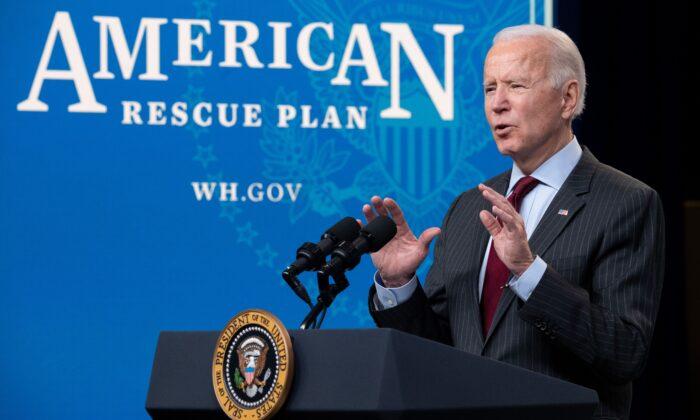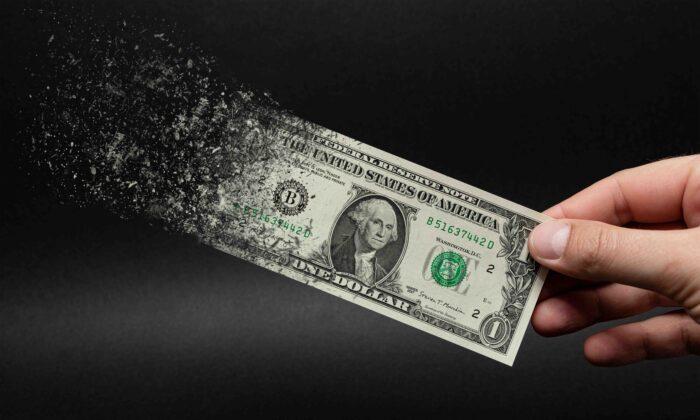“Initial estimate of fourth-quarter 2021 annualized real gross domestic product (GDP) showed that the bulk of recent economic growth and ‘recovery,’ in second-half 2021, reflected no more than a continued, accelerating pace of buildup in unsold inventories, resulting from extraordinarily weak demand. ... Of the stronger than expected headline fourth-quarter 2021 real annualized GDP growth of 6.89%, final sales (GDP net of the excess inventory buildup) was just 1.88%; that followed weaker than expected third-quarter 2021 real annualized GDP growth of 2.30%, with final sales of just 0.08%, net of the buildup of unsold inventories in that quarter,” said John Williams, founder of Shadow Government Statistics.
You may have heard President Joe Biden crowing about the January jobs report on Feb. 4. In case you were taking a bathroom break during that part of the news broadcast, here’s what Biden said:
“Today we learned that in January, our economy created 467,000 jobs. But that’s not all. We learned that job growth in November and December over last year was revised up by more than 700,000 jobs.
“This morning’s report caps off my first year as president. And over that period, our economy created 6.6 million jobs—6.6 million jobs.
“If you can’t remember another year when so many people went to work in this country, there’s a reason: It never happened,” he said.
I don’t know whether the notion of a Freudian slip applies to comments that are read off a teleprompter? If so, Biden’s slip was hilarious.
“It never happened.” What a joke.
The 6.6 million jobs he crows about creating “never happened.” In that alone, he is right. Far from creating 467,000 jobs, the U.S. economy lost jobs last month, as it tends to do in January.
ADT, the private employment services company that calculates from real numbers reports that U.S. companies SHED 301,000 employees last month. That is credible evidence of a weakening economy, not one in the midst of a growth surge.
The Labor Department’s official numbers don’t entirely show the real picture. Take a closer look at the government’s own statistics. If you discount their “seasonal revisions,” which can be pure poppycock, the U.S. Bureau of Labor Statistics (BLS) data shows that the economy lost 272,000 jobs last month before adjustment.
From this more realistic perspective, you could say that government accounting gimmicks (lies) conjured 1.441 million jobs out of thin air.
BLS flunkies can “create jobs” by manipulating data on spreadsheets. But these data have little connection to the real world. Hence the record number of 6.6 million jobs Biden is so proud of “never happened.”
No one draws a paycheck from a “spreadsheet job” that only exists as a statistical manipulation. These fabrications don’t pay payroll or income taxes and contribute to closing the multitrillion-dollar annual budget deficit, much less helping retire the $30 trillion national debt.
Nor will Biden’s fake prosperity help the Democrats retain control of Congress in the midterm elections. Strong evidence of that effect comes from the University of Michigan’s final January 2022 Index of Consumer Sentiment. It dropped to a new 10-year low, save only for the fact that January 2021 continues to hold the distinction of being the only other month in the past decade, due to the pandemic, of being a more pessimistic time.
Of course, some people are perfectly capable of being captivated by bogus statistics. The University of Michigan Consumer Sentiment suggests that people are finding their own finances and prospects disappointing. Otherwise governments wouldn’t go to such pains to lie about the economy.
Dr. Richard Curtin, Surveys of Consumers chief economist, reports a sharp drop in consumer confidence since April of last year, with the Sentiment Index plunging by 23.9 percent, a drop Curtin attributes to the Delta and Omicron variants of COVID-19. He suggests that “household spending had been supported by an extraordinary pace of rising home and stock prices that is likely to turn negative in the year ahead.”
“Overall confidence in government economic policies is at its lowest level since 2014, and the major geopolitical risks may add to the pandemic active confrontations with other countries. Although their primary concern is rising inflation and falling real incomes, consumers may misinterpret the Fed’s policy moves to slow the economy as part of the problem rather than part of the solution,” Curtin stated.
If that is the common take, everyday people may be more clued to the economy than the Federal Reserve governors. As Williams of Shadow Government Stats suggests, the appearance of strength in recovering from the COVID-19 pandemic is mostly an illusion.
“Against headline annualized real quarterly Fourth-Quarter 2021 GDP growth of 6.89%, and Third-Quarter growth of 2.30%, Final Sales (GDP net of Inventory Change) respectively gained only 1.88% in Fourth-Quarter 2021 and 0.08% in Third-Quarter 2021. The problem was a massive involuntary inventory buildup due to a significant faltering in consumer demand,” Williams stated.
The faltering demand was in play in the Christmas shopping bust. If the Fed proceeds to raise rates to slow a rapidly growing economy, the already faltering economy could take a nosedive even worse than the initial COVID-19 collapse.





